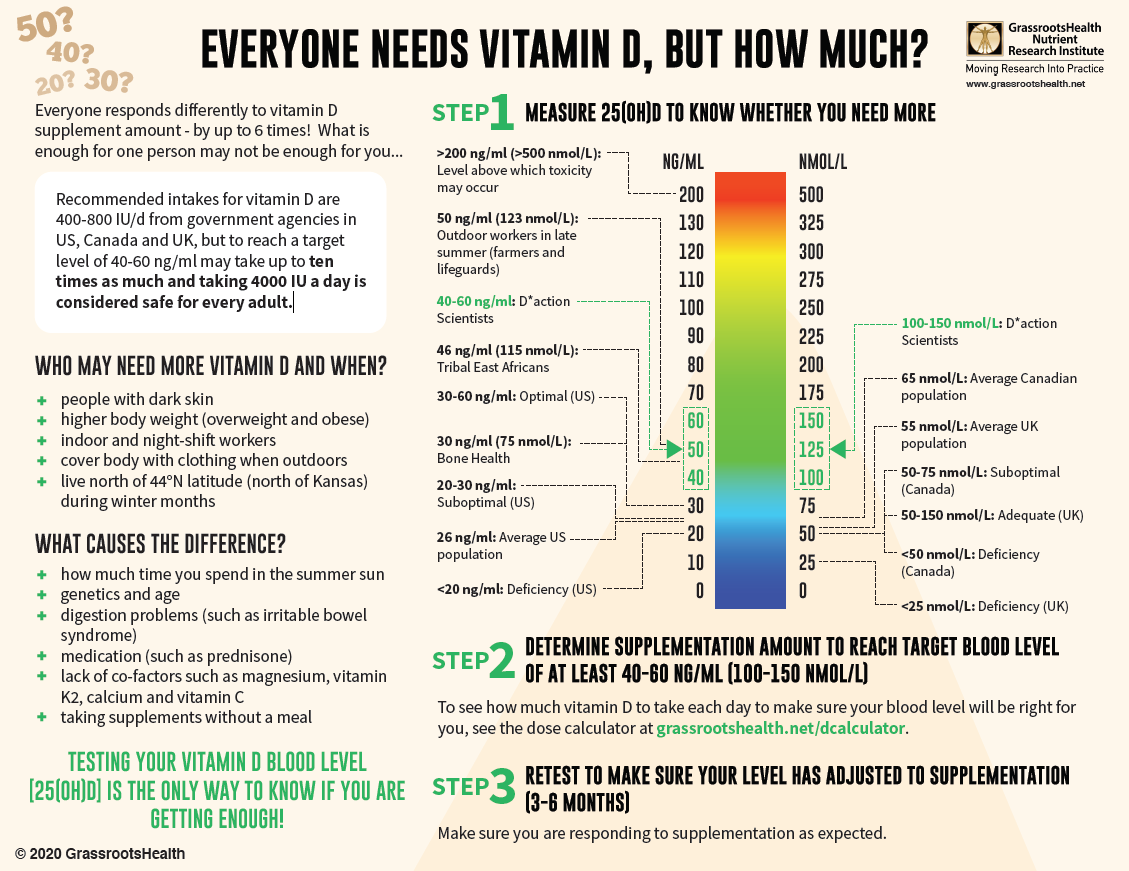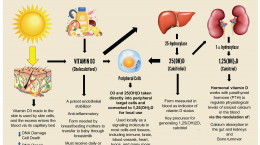Published on November 27, 2020
This one-page infographic has all the basic information anyone needs to get started with vitamin D – share it today!
Have you ever felt like you wanted to tell someone about vitamin D but didn’t know where to start? Or what information to give them that was most important?
GrassrootsHealth, along with some of the top vitamin D researchers in the world, have put together the infographic below to present an easy-to-comprehend visual handout to get anyone started on vitamin D.
What is so important about this information?
One of the most important messages conveyed with this graphic is that simply taking a vitamin D supplement may not be providing enough vitamin D, especially when the current medical recommendations are too low for almost all people.
Recommended intakes for vitamin D are 400-800 IU/d from government agencies in US, Canada and UK, but to reach a target level of 40-60 ng/ml may take up to ten times as much and taking 4000 IU a day is considered safe for every adult.
An intake of 400 to 800 IU of vitamin D per day, especially during the winter when many people are stuck indoors, is certainly not enough vitamin D to support the levels needed for maintaining your health! Obvious consequences of such low recommendations are the current average vitamin D levels among the general population, such as a level of 26 ng/ml for the United States. Vitamin D scientists recommend maintaining a vitamin D level of 40-60 ng/ml (100-150 nmol/L) however, the amount needed for one person to achieve such levels may be much different than the amount needed for others.
Who May Need More Vitamin D and When?
- people with dark skin
- higher body weight (overweight and obese)
- indoor and night-shift workers
- cover body with clothing when outdoors
- live north of 44°N latitude (north of Kansas)
- during winter months
What Causes The Difference?
- how much time you spend in the summer sun
- genetics and age
- digestion problems (such as irritable bowel syndrome)
- medication (such as prednisone)
- lack of co-factors such as magnesium, vitamin K2, calcium and vitamin C
- taking supplements without a meal
How to Know You’re Getting Enough Vitamin D
The only way to make sure that your target level of vitamin D has been reached is to measure the amount of vitamin D [as 25(OH)D] in your blood. If your resulting level is below your target, using the vitamin D calculator to help determine a new supplementation amount along with information provided on how to support and maintain a healthy vitamin D level (such as with co-nutrients, sun exposure, and food). Re-testing after 3 to 6 months allows you to ensure your target has been reached, or gives you the opportunity to adjust your routine as needed.
Don’t Allow a Vitamin D Deficiency to Bring Your Health Down!
Correcting a vitamin D deficiency prior to getting sick may decrease disease severity and improve outcomes! Test your vitamin D level today, learn what steps to take to improve your level, and take action to achieve and maintain a vitamin D level of 40-60 ng/ml (100-150 nmol/L).
Using the GrassrootsHealth Custom Kit Builder, you can create a test kit that measures your status of vitamin D and other important nutrients (such as omega-3s, zinc and magnesium), as well as your CRP level to measure inflammation. Click here to build and order your test kit today – measure your status and take the steps necessary to improve them if needed; make an impact on your health today and for your future! When you know what your levels are, you can determine next steps to take and how much supplementation may be needed if you are not at your target levels.







